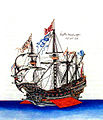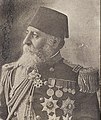Ottoman Navy
This article needs additional citations for verification. (June 2010) |
| Ottoman Navy | |
|---|---|
Tripolitanian War | |
| Commanders | |
| Kapudan Pasha (1567–1867) |
|
| Minister of the Navy (1867–1922) |
|
| Fleet Commander (1877–1922) | (last) |
| Military of the Ottoman Empire |
|---|
 |
The Ottoman Navy (
During its long existence, the Ottoman Navy was
For much of its history, the Navy was led by the
After the
History
Pre-Ottoman Turkish fleets
The first Turkish naval fleet in
Rise (1299–1453)
Expansion to the Aegean, Black, Ionian and Adriatic Seas
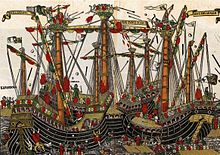
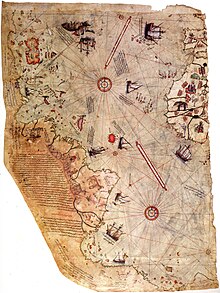
The conquest of the island of Kalolimno (İmralı Island) in the Sea of Marmara in 1308 marked the first Ottoman naval victory. The Ottoman fleet made its first landings on Thrace in 1321. The first Ottoman fortress in Europe was built in 1351, and the Anatolian shores of the strategic Bosporus Strait near Constantinople in 1352, and both shores of the equally strategic Dardanelles Strait were conquered by the Ottoman fleet.
In 1373 the first landings and conquests on the Aegean shores of Macedonia were made, which was followed by the first Ottoman siege of Thessaloniki in 1374. The first Ottoman conquest of Thessaloniki and Macedonia were completed in 1387. Between 1387 and 1423 the Ottoman fleet contributed to the territorial expansions of the Ottoman Empire on the Balkan peninsula and the Black Sea coasts of Anatolia. Following the first conquests of Venetian territories in Morea, the first Ottoman-Venetian War (1423–1430) started.
In the meantime, the Ottoman fleet continued to contribute to the expansion of the Ottoman Empire in the Aegean and Black Seas, with the conquests of Sinop (1424), Smyrna (1426) and the reconquest of Thessaloniki from the Venetians (1430). Albania was reconquered by the Ottoman fleet with landings between 1448 and 1479.
Growth (1453–1683)
In 1453 the Ottoman fleet participated in the historic conquests of
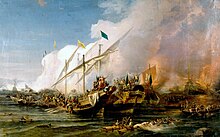
In the following period the Ottoman fleet gained more territory in the Aegean Sea, and in 1475 set foot on Crimea on the northern shores of the Black Sea. Until 1499 this was followed by further expansion on the Black Sea coasts (such as the conquest of Georgia in 1479) and on the Balkan peninsula (such as the final reconquest of Albania in 1497, and the conquest of Montenegro in 1499). The loss of Venetian forts in Montenegro, near the strategic Castelnuovo, triggered the Ottoman-Venetian War of 1499–1503, during which the Turkish fleet of Kemal Reis defeated the Venetian forces at the Battle of Zonchio (1499) and the Battle of Modon (1500). By 1503 the Ottoman fleet raided the northeastern Adriatic coasts of Italy, and completely captured the Venetian lands on Morea, the Ionian Sea coast and the southeastern Adriatic Sea coast.
According to Kâtip Çelebi a typical Ottoman fleet in the mid-17th century consisted of 46 vessels (40 galleys and 6 maona's) whose crew was 15,800 men, roughly two-thirds (10,500) were oarsmen, and the remainder (5,300) fighters.[2]
Expansion to the Levant and Maghreb, operations in the West Mediterranean



Starting from the conquest of
In 1527 the Ottoman fleet participated in the conquest of
In 1541, 1544, 1552 and 1555, the Spanish-Italian fleet of Charles V under the command of Andrea Doria was defeated in Algiers, Naples, Ponza, and Piombino, respectively.
Operations in the Indian Ocean and the final conquests in North Africa


In the meantime, the Ottoman Indian Ocean Fleet, based in
Between 1547 and 1548, Yemen was reconquered from the Portuguese, while in the Persian Gulf and Arabian Sea, other important Portuguese ports such as Oman and Qatar were conquered in 1552,[3] but the Ottomans failed to take Hormuz Island and therefore the control of the Persian Gulf remained firmly in Portuguese hands.[4]
In 1565 the
The Ottoman naval victory at the
Operations in the Atlantic Ocean
Starting from the early 17th century, the Ottoman fleet began to venture into the Atlantic Ocean (earlier,
Black Sea operations
Before the Ottomans, the
In the years following their
The failure of the
Guillaume Levasseur de Beauplan, a French military engineer, provided a first-hand account of the Cossack operations and their tactics against the Turkish ships and towns on the Black Sea Coast.[13][15] The high point of the Cossack attacks came in 1637, when a large party of Zaporozhian and Don Cossacks laid siege to the fortress of Azov. After a two-month land and sea battle, the fortress was conquered by the Cossacks.[13]
The Ottoman Navy also engaged in blockades of Georgia's western coast during the sixteenth and seventeenth centuries in order to coerce local kingdoms into submission.
Stagnation (1683–1827)
In the rest of the 17th and 18th centuries, however, the operations of the Ottoman fleet were largely limited to the

The 18th century was a period of stalemate for the Ottoman fleet, with numerous victories matched by equally numerous defeats. Important Ottoman naval victories in this period included the reconquest of Moldavia and Azov from the Russians in 1711. The Ottoman–Venetian War of 1714–1718 saw the reconquest of Morea from the Venetians and the elimination of the last Venetian island strongholds in the Aegean.
For most of the 18th century, during a period of time in the eastern Mediterranean known by some as the Pax Ottomana, the focus of the Ottoman Navy was both on defining and defending its territorial waters from rival states and enforcing its authority over them as well as increasingly on protecting international trade routes and defending its maritime commerce from the constant problem of piracy.[16]
However, during the
During the
| Size of crew in Ottoman ships in 1699 and 1738[17] | ||||||||||||||||||||
|---|---|---|---|---|---|---|---|---|---|---|---|---|---|---|---|---|---|---|---|---|
| Size of crew | ships in 1699 | ships in 1738 | ||||||||||||||||||
| 1500 | - | 1 | ||||||||||||||||||
| 1300 | - | 1 | ||||||||||||||||||
| 1100 | - | 1 | ||||||||||||||||||
| 1000 | - | 1 | ||||||||||||||||||
| 800 | - | 6 | ||||||||||||||||||
| 750 | - | 5 | ||||||||||||||||||
| 650 | - | 4 | ||||||||||||||||||
| 600 | 1 | - | ||||||||||||||||||
| 500 | - | 1 | ||||||||||||||||||
| 450 | - | 7 | ||||||||||||||||||
| 400 | 2 | 3 | ||||||||||||||||||
| 350 | 3 | 1 | ||||||||||||||||||
| 300 | 8 | 1 | ||||||||||||||||||
| 250 | 3 | 1 | ||||||||||||||||||
| 200 | 3 | - | ||||||||||||||||||
| Total | 20 | 33 | ||||||||||||||||||
| Note: Between 1699 and 1738 the Ottoman navy started to use more sailing ships who needed more crew on each ship instead of galleys with less men. | ||||||||||||||||||||
Danube fleet
The size of the
Decline (1827–1908)


The 19th century saw further decline in Ottoman naval power, despite occasional recovery. Following the defeat against the combined British-French-Russian fleet at the
In 1875, during the reign of Sultan
Nordenfelt-class Ottoman submarine Abdül Hamid (1886) was the first submarine in history to fire a torpedo while submerged under water.[24] Two submarines of this class, Nordenfelt II (Abdül Hamid, 1886) and Nordenfelt III (Abdül Mecid, 1887) were built for the Ottoman Navy. They were built in pieces by Des Vignes (Chertsey) and Vickers (Sheffield) in England, and assembled at the Taşkızak Naval Shipyard in Constantinople (Istanbul). These submarines were an attempt to gain an edge over the Greek navy (which had only one Nordenfelt submarine, a smaller and older version). However, it was quickly realized that – like the other Nordenfelt submarines ordered by Russia – they suffered from stability problems and were too easy to swamp on the surface. The Turks could not find a crew that was willing to serve on the primitive submarines. Abdül Hamid ended up rotting at dock, while Abdül Mecid was never fully completed.[25]
Dissolution (1908–1922)
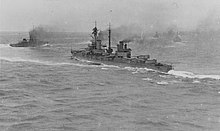
Following the Young Turk Revolution in 1908, the Committee of Union and Progress which effectively took control of the country sought to develop a strong Ottoman naval force. The poor condition of the fleet became evident during the Ottoman Naval Parade of 1910, and the Ottoman Navy Foundation was established by the Ottoman government in order to purchase new ships through public donations. Those who made donations received different types of medals according to the size of their contributions.
In 1910, the Ottoman Navy purchased two pre-dreadnought battleships from Germany: SMS Weissenburg and her sister ship SMS Kurfürst Friedrich Wilhelm. These ships were renamed Turgut Reis and Barbaros Hayreddin, respectively.
The

In the aftermath of the Balkan Wars, the Ottomans remained engaged in a dispute over the sovereignty of the
World War I and aftermath
The Ottomans' first military action in the

In 1915 at the
In the last year of World War I, while returning from a bombardment mission of the Allied port of
Following the end of
After the independence of the
Admirals

Famed Ottoman admirals include:
- Second Battle of Lepantoin 1500
- Hayreddin Barbarossa, who defeated the fleet of the Holy League of Charles V under the command of Andrea Doria at the island of Peñón in 1531, Battle of Preveza in 1538 and Algiers in 1541
- Turgut Reis (known as Dragut in the West), who conquered Libya in 1551 and defeated the fleet of Charles V under the command of Andrea Doria at the Battle of Ponzain 1552
- Piyale Pasha, who defeated the Holy League of Philip II of Spain under the command of Giovanni Andrea Doria at the Battle of Djerbain 1560
- Aruj, who established the Ottoman presence in North Africa which lasted four centuries
- Salih Reis, who conquered Moroccoin 1553 and extended Ottoman territory into the Atlantic Ocean
- Third Battle of Lepanto in 1571 and conquered Tunisiafrom Spain in 1574
- Murat Reis, who fought the Portuguese in the Indian Ocean between 1552 and 1554 and captured Lanzarote of the Canary Islands in the Atlantic Ocean in 1585
- Seydi Ali Reis (known as Sidi Ali Reis in the West), who fought the Portuguese in the Indian Ocean in 1554 and is famous for his books of travel which have been translated into many languages
- Kurtoğlu Muslihiddin Reis (known as Curtogoli in the West), who played an important role in the conquests of Egypt in 1517 and Rhodes in 1522, and established the Ottoman Indian Ocean Fleet based in Suez which was later commanded by his son, Kurtoğlu Hızır Reis, who led the Ottoman naval expedition to Aceh (1568–1569) which marked the easternmost territorial expansion of the Ottoman Empire
The Ottoman admiral and cartographer Piri Reis crafted maps and books of navigation, including his first world map (1513) which is one of the oldest surviving maps of America and possibly the oldest surviving map of Antarctica. The first world map (1513) and second world map (1528) of Piri Reis are today preserved at the Library of Topkapı Palace in Istanbul. Other works of Piri Reis are preserved at the Naval Museum in Istanbul.[27]
The Istanbul Naval Museum is located in the Beşiktaş district of Istanbul, Turkey. It was established in 1897 by the Ottoman Minister of the Navy (Bahriye Nazırı) Bozcaadalı Hasan Hüsnü Pasha.[32][33]
The museum contains an important collection of military artifacts pertaining to the Ottoman Navy.
Being connected to the Turkish Naval Forces Command, it is also the country's first military museum.[34]
In the early 21st century a new exhibition building was constructed. The construction began in 2008, and the building was reopened on October 4, 2013. It has two floors above ground level and one basement floor, all covering 20,000 m2 (220,000 sq ft).[34]
The basement consists of diverse items like figureheads, ornaments of naval ships, ship models, and pieces of the Byzantine chain that was used for blocking the entrance of the Golden Horn during the Ottoman conquest of Constantinople (Istanbul) in 1453. In the first and second floors, a large number of imperial and other caïques are exhibited.
Many exhibition items underwent special restoration and conservation works due to deformation of the raw materials caused by heat, light, humidity, atmospheric conditions, vandalism and other factors.[34]
Gallery
-
"Göke" (1495) was the flagship of Kemal Reis
-
Uluç Ali Reis
-
Bozcaadalı Hasan Hüsnü Pasha (1890)
-
Ali Osman Pasha
-
Halil Pasha (1910)
-
Fuat Hüsnü Kayacan
-
Naval uniform (1909–1916)
-
Naval uniform (1909–1916)
-
Naval uniform (1916–1925)
-
Naval uniform (1916–1925)
-
Muzaffer Adil Bey
Ships
- List of battleships of the Ottoman Empire
- List of cruisers of the Ottoman Navy
- List of major surface ships of the Ottoman steam navy
- List of mine warfare vessels of the Ottoman steam navy
- List of non-combat vessels of the Ottoman steam navy
- List of patrol vessels of the Ottoman steam navy
- List of sail frigates of the Ottoman Empire
- List of ships of the line of the Ottoman Empire
- List of wrecked or lost ships of the Ottoman steam navy
See also
- List of Ottoman sieges and landings
- List of Fleet Commanders of the Ottoman Navy
- List of Kapudan Pashas
- Turkish Navy
- The Ottomans: Europe's Muslim Emperors
References and sources
- ^ Suciu, Peter (5 March 2022). "Turkey Could Be a Naval Power in Europe Again". The National Interest. Retrieved 9 March 2022.
- ^ Ottoman Warfare 1500–1700, Rhoads Murphey, 1999, p. 23
- ^ Peter Malcolm Holt, Ann K. S. Lambton, Bernard Lewis The Cambridge history of Islam 1977.
- ^ Soucek, Svat (June 2013), "Piri Reis. His uniqueness among cartographers and hydrographers of the Renaissance", in Vagnon, Emmanuelle; Hofmann, Catherine (eds.), Cartes marines : d'une technique à une culture. Actes du colloque du 3 décembre 2012., CFC, pp. 135–144, archived from the original (PDF) on 27 June 2018, retrieved 21 August 2016
- ^ a b c d e Turkish Navy Official Website: "Atlantik'te Türk Denizciliği"[permanent dead link] Szkk.tsk.tr
- ISBN 978-1-84603-240-0.
- ^ Turkish Raid – anniversary exhibition in Westman Islands at 5 pm Archived 22 July 2011 at the Wayback Machine
- ^ "Discover South Iceland - Vestmannaeyjar, The Westman Islands". Archive.is. 24 July 2008. Archived from the original on 24 July 2008. Retrieved 20 July 2011.
- ^ "Barbary pirates in Ireland: The Sack of Baltimore, Co. (...)". Divainternational.ch. Retrieved 11 May 2019.
- ^ "The O'Brien Press - The Stolen Village - Baltimore and the Barbary Pirates By Des Ekin". Obrien.ie. Retrieved 11 May 2019.
- ISBN 978-0-520-26859-3
- ^ "The Ottoman Navy". Naval Historical Society of Australia. 6 September 1978.
- ^ ISBN 978-0-19-924161-3pp. 125, 131, 133–134
- ISBN 978-0-8160-6259-1p. 450
- ^ "Guillaume Le Vasseur de Beauplan. Description d'Ukranie, qui sont plusieurs provinces du Royaume de Pologne". Litopys.org.ua. Retrieved 11 May 2019.
- . Retrieved 2 November 2022.
- ^ Arming the State: Military Conscription in the Middle East and Central Asia, Erik J. Zurcher, p. 45
- ^ Ottoman Warfare 1500-1700, Rhoads Murphey, 1999, p. 235
- ISBN 978-0-415-21478-0.
- ^ ISBN 1557507260.
- ^ "Submarine Heritage Centre – Submarine History of Barrow-in-Furness". Submarineheritage.com. Archived from the original on 4 July 2007. Retrieved 11 May 2019.
- ^ kadem, which translates as "foot", is often misinterpreted as equivalent in length to one imperial foot, hence the wrongly converted dimensions of "201 x 56 ft, or 62 x 17 m" in some sources.
- ^ Mehmet Hacısalihoğlu, "Inclusion and Exclusion: Conscription in the Ottoman Empire", J.of Modern European History, Vol. 5, No. 2 (2007), pp 266, 269
- ^ "Submarine Heritage Centre – Submarine History of Barrow-in-Furness". Submarineheritage.com. Archived from the original on 4 July 2007. Retrieved 11 May 2019.
- ^ "The Invention of the Submarine". Archived from the original on 19 December 2012. Retrieved 6 July 2007.
- ^ See Massey, Castles of Steel
- ^ "Turkish Naval Museum - Main Page". Archived from the original on 26 February 2009. Retrieved 20 July 2011.
- ^ a b c d "The Historical Galley". denizmuzesi.dzkk.tsk.tr. 24 November 2021. Archived from the original on 8 October 2021.
- ^ a b c d "Liphschitz, N., 2014. The Kadirga galley in Istanbul – The Turkish Sultan's Caique: A dendrohistorical research. In: Environment and Ecology in the Mediterranean Region II (eds. R. Efe and M. Ozturk). Cambridge Scholars Pub. Pp.39-48. Cambridge".
- ^ a b "Cornucopia Magazine". www.cornucopia.net. Retrieved 16 March 2022.
- ^ a b "Center for Maritime Archaeology and Conservation - Texas A&M University". nautarch.tamu.edu. Retrieved 24 November 2021.
- ^ a b The World of Learning 2004 by Michael Salzman p.1670
- ^ "Archived copy". Archived from the original on 30 September 2012. Retrieved 30 August 2011.
{{cite web}}: CS1 maint: archived copy as title (link) - ^ a b c "Main Page". Deniz Müzeleri. Archived from the original on 11 November 2014. Retrieved 11 November 2014.
Bibliography
- E. Hamilton Currey, Sea-Wolves of the Mediterranean (London, 1910). ISBN 978-1500883430
- Bono, Salvatore: Corsari nel Mediterraneo (Corsairs in the Mediterranean) (Perugia, Oscar Storia Mondadori, 1993); Corsari nel Mediterraneo: Condottieri di ventura. Online database in Italian, based on Salvatore Bono's book.
- Bradford, Ernle, The Sultan's Admiral: The life of Barbarossa (London, 1968). ISBN 978-1845117931
- Wolf, John B., The Barbary Coast: Algeria under the Turks (New York, 1979). ISBN 978-0393012057
- Melis, Nicola, "The importance of Hormuz for Luso-Ottoman Gulf-centred policies in the 16th century: Some observations based on contemporary sources", in R. Loureiro-D. Couto (eds.), Revisiting Hormuz – Portuguese Interactions in the Persian Gulf Region in the Early Modern Period (Wiesbaden, Harrassowitz, 2008, 107–120 (Maritime Asia, 19).
- Tuncay Zorlu, Innovation and Empire in Turkey: Sultan Selim III and the Modernisation of the Ottoman Navy (London, I.B. Tauris, 2011). ISBN 978-1848857827
External links
- The Ottomans: Comprehensive and detailed online chronology of Ottoman history in English.
- Turkish Navy official website: Historic heritage of the Turkish Navy (in Turkish)
- Turkish Navy official website: Turkish seamen in the Atlantic Ocean (in Turkish)
- Istanbul Naval Museum Official Website
- History of the Ottoman Navy
- See World War I ship list Battleships-Cruisers.co.uk.
Representations in popular culture
- The Ottoman Navy and Admiral Hayreddin Barbarossa are depicted in the novel The Sultan's Admiral: Barbarossa: Pirate and Empire Builder by Ernle Bradford.
- The Ottoman Navy, Admiral Turgut Reis, and the Siege of Malta are depicted in the novel The Religion by Tim Willocks.
- The Ottoman Navy and Admiral Kemal Reis are portrayed in the novel The Sultan's Helmsman by Robert Colburn.

